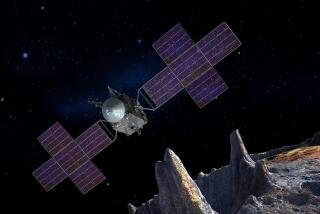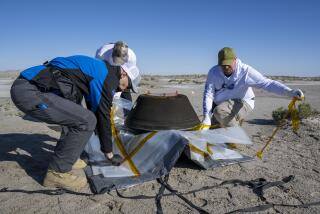Scientists ‘Fish’ on Sea Floor for Ancient Key to Life
- Share via
BERKELEY — Scientists are studying sediments on the sea floor to learn if asteroids colliding with ancient Earth could have provided the planet with the chemical building blocks needed for the creation of life.
“The question we have to ask is can these organic compounds (needed for life) survive something as catastrophic as a large-impact event?” said marine chemist Jeffrey Bada of the Scripps Institution of Oceanography in La Jolla.
Studies by Bada, Mei-Xun Zhao and Nancy C. Lee at Scripps and Stanford University chemist Richard Zare have failed to yield a definite answer, Bada said recently during the Eighth International Conference on the Origin of Life.
Their chemical analysis of sediments from beneath the Pacific Ocean suggests, however, that when Earth was struck by asteroids or comets rich in amino acids, no more than 1% of those chemical building blocks of life could have emerged intact from the collisions, Bada said.
That small percentage could have supplied part of the material required for life to begin, he said. But his findings do not damage the prevailing theory that much of the material was formed on Earth, even if some came from outer space, he added.
Dust on Sea Floor
An asteroid striking Earth would put a lot of dust in the atmosphere. The dust would be deposited on the sea floor as sediment. If the asteroid contained amino acids and those chemicals reached Earth intact, they should be found in the sediments.
So Bada and his colleagues decided to examine sea floor sediments to learn if they contained aib, a type of amino acid that is rare on Earth but abundant on certain meteorites.
Because no sediments are known to exist from the time life emerged sometime between 3.5 billion and 4.5 billion years ago, there was no way to learn directly if an asteroid striking the very young Earth actually brought amino acids to the planet.
So Bada and his colleagues examined certain sediments that were deposited 65 million years ago--a time when many scientists believe a large asteroid or comet smashed into Earth to kick up huge dust clouds, blot out sunlight and spur extinction of the dinosaurs.
A complex chemical analysis showed that 65-million-year-old sediments from the Pacific sea floor may contain up to a few parts per billion of aib and that younger and older sediments contain none, Bada said.
Based on the amount of aib found in meteorites rich in organic chemicals, Bada calculated that if all the amino acids on an asteroid or other extraterrestrial object survived a collision with Earth, the sediments should contain 100 times more aib.
Debate Over Atmosphere
So he concluded that less than 1% of the amino acids on an asteroid colliding with Earth actually would reach the planet to help give rise to life.
The question of whether extraterrestrial objects provided some of the basic materials for life on Earth is tied to an ongoing debate over the makeup of the planet’s early atmosphere and whether atmospheric gases produced a chemical soup in the oceans that gave rise to life.
In a famous early 1950s experiment, scientist Stanley Miller showed that bombarding a mixture of hydrogen, methane, ammonia and water vapor with electricity produced an array of amino acids. That and similar experiments firmly implanted the idea that Earth’s early atmosphere was rich in those gases.
Atmospheric chemists challenged the theory in recent years, however, producing evidence that such gases would vanish quickly and that Earth’s early atmosphere was mostly carbon dioxide and nitrogen.
The problem is that such an atmosphere would not easily produce the organic building blocks for life, so some atmospheric scientists argued that amino acids could have come from extraterrestrial objects.
Bada said he and many organic chemists believe Earth’s early atmosphere must have contained enough hydrogen, methane and ammonia to allow the creation of amino acids. He said his study failed to turn up compelling evidence to support the alternative view that asteroids contributed significantly to the supply of building blocks for life.
Other scientists challenge the whole notion that life arose from organic materials on Earth, arguing that common clay could act as a chemical factory to generate life.






